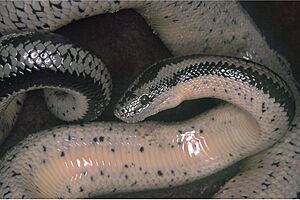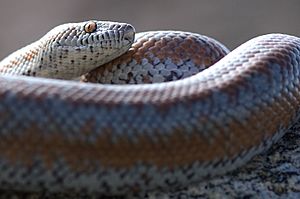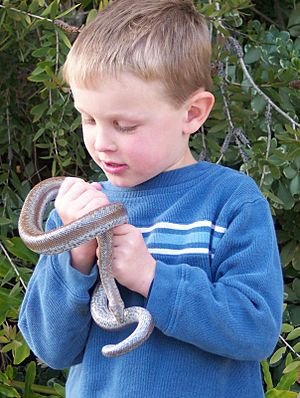Desert rosy boa facts for kids
Quick facts for kids Desert rosy boa |
|
|---|---|
 |
|
| Conservation status | |
| Scientific classification | |
| Genus: |
Lichanura
|
| Species: |
trivirgata
|
| Synonyms | |
|
|
The desert rosy boa (Lichanura trivirgata) is a cool snake found in the southwestern United States and parts of Mexico. It's a type of boa snake, but it's much smaller than the giant boas you might imagine. Rosy boas are known for their calm nature and pretty colors. They are one of only four boa species that live in the continental U.S.
Contents
What is a Rosy Boa?
The desert rosy boa got its scientific name, Lichanura trivirgata, from Edward Drinker Cope in 1861. The "trivirgata" part of its name means "three-striped." This is because most rosy boas have three distinct stripes on their bodies.
Types of Rosy Boas
Scientists recognize at least four different types, or subspecies, of rosy boas. These include:
- Arizona rosy boa, L. t. arizonae
- Desert rosy boa, L. t. gracia – This one often has pink, orange, or tan stripes.
- Baja rosy boa, L. t. saslowi
- Mexican rosy boa, L. t. trivirgata – This type usually has pale cream stripes.
What Does a Rosy Boa Look Like?
Desert rosy boas are small snakes. They usually grow to be about 43 to 112 centimeters (17 to 44 inches) long. That's about the length of your arm! They are some of the smallest members of the Boidae family. A big adult rosy boa is only about as wide as a golf ball.
Their colors can be very different depending on where they live. Some rosy boas have a rosy or salmon color on their bellies. Others have dark or orange spots on a lighter background.
Almost all rosy boas have at least a hint of three stripes. One stripe goes down the middle of their back. The other two are on their lower sides. These stripes can be very clear and straight, or they can be broken up. The stripes can be orange, maroon, rust, brown, or black. The spaces between the stripes can be gray, yellow, or tan.
Where Do Rosy Boas Live?
The desert rosy boa lives in dry, desert areas. You can find them in the southwestern United States, in California and Arizona. They also live in northwestern Mexico, in Baja California and Sonora.
In California, they live in the very southern part of San Diego County. In Arizona, they live in the western areas of the Sonoran Desert. In Mexico, they range south through the Sonoran Desert. They are found almost everywhere in Baja California, except in super dry or rocky areas.
How Do Rosy Boas Behave?
Desert rosy boas spend most of their time hidden. They hide under rocks and in cracks to stay safe from the weather and animals that might eat them. They especially like areas with granite rocks. Sometimes, they use burrows made by rodents if there aren't many rocks around.
Rosy boas are active when the weather is good. They are usually sleepy during the cold winter months. This sleepy state is called brumation. Spring is their breeding season, so they are most active then. You might see them looking for mates. They also come out to find food or new places to live.
Rosy boas can be active any time of day. But when it's hot, they mostly come out at night. In spring, they might be out in the afternoon or early evening. Their activity also depends a lot on moisture. If it's very dry, they stay deep underground to stay hydrated. After it rains, they often become very active on the surface.
What Do Rosy Boas Eat?
Desert rosy boas mostly eat small mammals. This includes pack rats, baby rabbits, deer mice, and kangaroo rats. Sometimes, they also eat lizards, amphibians, other snakes, or birds.
Rosy boas are very slow snakes. They can't chase their food. Instead, they wait quietly or sneak up on their meals. When a meal is close, they strike quickly. They grab their prey with tiny, sharp teeth. Then, they squeeze the animal until it can't breathe. This is called constriction.
How Do Rosy Boas Defend Themselves?
The desert rosy boa is very calm when people find it. If it feels threatened, it usually rolls into a tight ball with its head tucked inside. It usually won't bite to defend itself. Instead, it might release a stinky musk from its tail. This smell helps scare away predators.
Rosy boas are not venomous. Their calm nature, simple needs, and pretty colors make them popular pets.
Rosy Boa Babies
Desert rosy boas give birth to live young. A mother usually has about six babies at a time. Newborn rosy boas are about 30 centimeters (12 inches) long.
Rosy Boas as Pets
Because they are calm and small, desert rosy boas make great pet snakes. Many rosy boas are bred in captivity. You can find different color variations because people have selectively bred them. With good care, pet rosy boas can live for more than 30 years!





